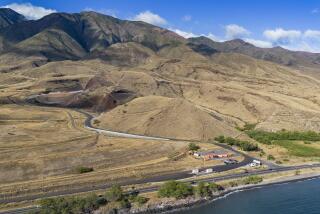Directors OK Toland Landfill Expansion
A regional garbage authority Thursday approved expanding the Toland Road Landfill over the objections of more than 60 farmers and nearby residents who say it signals the beginning of the end for agriculture in the Santa Clara Valley.
Faced with the imminent closure of Bailard Landfill in Oxnard, the Ventura Regional Sanitation District board of directors sees the project as the most economical and environmentally sound way to dispose of western Ventura County trash for the next 30 years.
The board voted 6 to 3 to expand Toland, making the dump, situated midway between Santa Paula and Fillmore, the most likely repository for most of the west county’s waste when Bailard reaches capacity this summer.
“We have a responsibility to plan for the future for our community and our community, frankly, is Ventura County,” Thousand Oaks board member Judy Lazar said. “The right thing to do is to continue on with the process and allow the county and other entities to weigh the conflicting needs of this county as a whole.”
The vote comes as a privately owned trash dump, the Simi Valley Landfill, is making a bid to handle much of the west county’s trash. But some city officials have balked at signing the pact, expressing concern that the exclusive nature of the deal could lead to a monopoly for the eastern Ventura County dump.
An expansion of Toland, owned and operated by the sanitation district, would provide needed competition for trash disposal, officials said Thursday. It could also eliminate the need for the hotly debated Weldon Canyon Landfill, which would lie between Ventura and Ojai.
The proposed expansion must still receive permits and approvals from several agencies, including the county Planning Commission and Board of Supervisors in a process that will not be completed until July at the earliest. Moreover, at least two separate legal challenges to the project are being considered.
Under the plan, Toland would be transformed from a small dump that accepts 130 tons of trash daily from Fillmore and Santa Paula to the west county’s largest. Up to 1,500 tons of trash a day from Thousand Oaks, Ventura, Oxnard, Camarillo, Port Hueneme and Ojai--as well as the two Santa Clara Valley communities--would flow to the landfill for the next 31 years. Dumping rates would drop between $10 and $15 a ton from Bailard’s current $33-a-ton fee.
“The benefits to the area outweigh the impacts,” Ventura board member Gary Tuttle said. “It’s a tough call. There are some environmental impacts, there’s no doubt about it.”
Indeed, the garbage district’s representatives from Santa Paula, Fillmore and Ojai all voted against the expansion. The board’s approval came even though the project will worsen noise and traffic in an area that already exceed county standards. But Toland will be cheaper and less environmentally harmful than trucking trash to landfills farther afield, district officials said.
That, however, did not comfort landfill opponents worried about potential damage to crops from dust and water contamination, as well as noise and safety concerns that increased truck traffic on California 126 will bring. More than 25 speakers predicted dire consequences for the rural area during the four-hour meeting.
“No matter what you do to mitigate the dust, air pollution, noise, airflow tampering and just plain human congestion that will inevitably accompany the new dump, you still risk throwing the microclimate out of balance, taking a beautiful valley of citrus and avocado orchards and changing it into an economic wasteland,” said Robert Sawyer, a Santa Paula attorney representing a group of farmers battling the expansion.
Sawyer said he is contemplating filing a lawsuit challenging an environmental document prepared for the proposed project. An attorney representing the Simi Valley Landfill said her clients are contemplating legal action too, also citing problems with the environmental impact report.
But district officials say local fears over the landfill are overblown.
“We wouldn’t want in any way to pose a threat to the valley’s agricultural vitality and the truth is we don’t believe we do,” said Ed McCombs, the district’s general manager.
The county Planning Commission and Board of Supervisors are expected to separately discuss the project in April. Permits must also be secured from the Regional Water Quality Control Board and California Integrated Waste Management Board.
More to Read
Sign up for Essential California
The most important California stories and recommendations in your inbox every morning.
You may occasionally receive promotional content from the Los Angeles Times.










